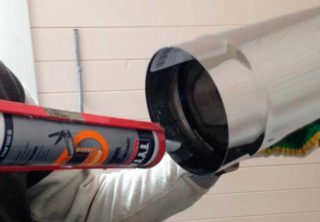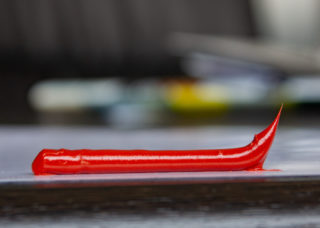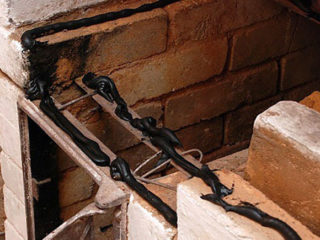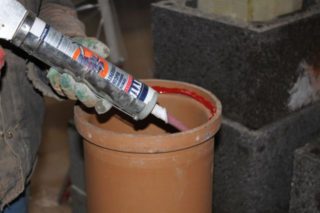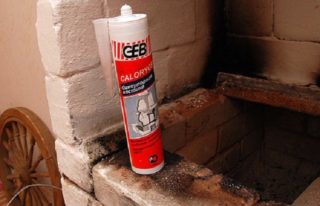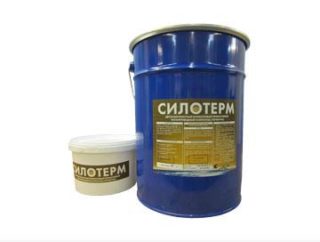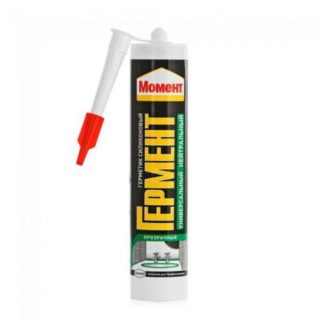To prevent cracking of bricks, sealing joints of masonry, cast-iron elements, cement and clay mixtures are no longer needed. High-temperature sealant tightly closes the gaps, eliminates the risk of smoke and material damage at high temperature. The paste is selected taking into account the limiting temperature regime, adhesion strength, hardening speed.
Purpose of heat-resistant sealants
When operating in intensive mode, the fireplace or stove is cracked. Slots also appear on aggregates without cladding, plaster and high temperature coatings. Depressurization of the chimney, furnace and other structural elements leads to the following consequences:
- increase in fuel consumption upon receipt of additional air masses;
- soot penetration into the room - a black coating appears on the walls or ceiling surface;
- poisoning of a person by combustion products;
- fire attenuation - in case of violation of the integrity of the chimney;
- soot settling on the inner surface of the chimney ducts due to the combustion of fuel at a low temperature;
- chimney ignition with oxygen access.
To protect stoves and fireplaces from these problems, heat-resistant sealant must be used.
Areas of use
Refractory paste material is used for several purposes:
- processing a compound of a ceramic or metal chimney duct;
- quality assurance for joining parts of sandwich chimneys;
- organization of the output of the pipe to remove smoke through the roof and rafters - the apron gaps are filled with sealant;
- waterproofing the seams of furnace devices and chimneys;
- installation of cast-iron parts (firebox, oven, hob) and repair work;
- restoration of the strength of the mortar for masonry, destroyed at high temperature load;
- decoration of the stove or fireplace construction;
- gluing heat-resistant gaskets made of asbestos or asbestos-graphite cord on doors, ovens, stoves, gate valves.
Some pastes can be used in the repair of fireclay masonry, but subject to a maximum temperature in the furnace up to 1500 degrees.
For threaded connections
Heat-resistant silicate-based polymers withstand temperature extremes from +1200 to +1500 degrees. This provides the possibility of their use in areas of seams and damage to the heating system - boilers, pipes, electric and gas type furnaces. The material is used as a gasket, which eliminates the release of carcinogens. The adhesion to the surface helps protect against heat loss and fuel leaks.
For stoves and fireplaces
Synthetic silicone materials with a high temperature resistance index are suitable for sealing joints in areas of contact with fire. Deep cracks cannot be filled with them, but for surface treatment with preliminary wetting of the surface it is allowed to use.
The best option for repairing furnace units is glue that is not exposed to chemicals, oils and aggressive gases. High-quality compounds give hybrids based on solvent and MS-polymer. During oxidation, the paste cures and solidifies.
For chimneys
Thermal sealant for brick chimneys of silicate-based furnaces allows to seal joints and cracks. A high degree of moisture resistance ensures use in outdoor areas. The material is not suitable for chimneys exposed to vibrations.
Silicone flash master shrink tapes are used as a sealant for metal chimneys. The strip that covers the joint melts when exposed to temperature. The seam becomes reliable and tight.
Varieties of compositions
For furnaces, it is possible to choose a high-temperature germetik with a different thermally insulating base. The first group of materials is available in the form of compositions that withstand direct exposure to flame, the second - in the form of pastes.
Silicone based
The heat-resistant composition is painted red-brown due to the addition of iron oxide. Pastes withstand temperatures from 170 to 300 degrees, do not lose elasticity after drying, do not undergo deformation loads. Silicone sealant is an unpainted waterproof material with the following technical parameters:
- packaging - a tube of 310 ml;
- drying time - about 20 minutes;
- application features - on a cold base at plus temperature (up to +40 degrees);
- depth of cracks for sealing - from 6 mm;
- UV resistance.
Using paste, it is possible to process a brick chimney from the side of the street, seal the joints of the roof with an extract, a chimney made of brick, metal in the presence of a boiler with an efficiency of 90%. The tool is also used to seal external cracks in the brickwork of fireplaces, threads of the heating circuit.
Silicate based
The viscosity of the furnace sealant and the black color are due to sodium silicate in the composition. The mixture loses elasticity after hardening, therefore it is suitable for heating equipment with low vibration loads. It features the following characteristics:
- the limit of short-term temperature - from 1400 to 1500 degrees, long-term - up to 1300 degrees;
- curing period - 15 min;
- maximum seam size - 15 mm;
- packing - in a plastic tube;
- temperature limit of use - from +1 to +40 degrees.
The adhesion of the compounds allows you to process metal, concrete or brick with a preliminary coating with an abrasive, but is not suitable for stationary parts. Silicate sealant is used for clearances in combustion chambers, chimneys in a bath, repair of masonry cracks, cast-iron parts, and repair of boilers operating for heating.
Sealant adhesives
Synthetic high-temperature composition - adhesive sealant is characterized by good adhesive qualities. The material is used for processing the base of furnaces, chimney ducts. It is resistant to acid-base environment, suitable for repair of gas heating. Glue also processes the water supply and drainage system.
Advantages and disadvantages
Advantages and disadvantages of the material depend on its basis. The benefits of high temperature silicone include:
- good adhesion;
- resistance to wet environment;
- resistance to UV radiation;
- maintaining the integrity of the structure during abrasive action;
- non-susceptibility to temperature fluctuations;
- ease of application.
Among the minuses - the inability to paint the surface, processing a wet base. Acid modifications are not compatible with all types of materials.
Silicate heat-resistant composition has the following advantages:
- maintaining integrity when exposed to high temperature;
- good indicator of strength;
- lack of shrinkage;
- the possibility of subsequent surface painting;
- long term of operation.
The disadvantages of the paste are the lack of elasticity, minimal adhesion to a smooth surface.
Properties and nuances of the choice of sealing pastes
Heat-resistant sealant for furnaces has several properties:
- The ability to withstand temperature effects. Heat-resistant heat up to 1500 degrees, heat-resistant - up to 300 degrees.
- Good connectivity. Rubber based silicone materials are used as glue for ceramics, wood, glass.
- Hardening rate. Depends on the number of components. One-component sealant hardens in 1 minute and is applied with a layer of 2-12 mm. Two-component (polymer + catalyst) harden in a few hours.
- Colour. Determined by additives in the composition. Reds are suitable for lining with a layer of 6 mm, are characterized by good adhesion. Black heat-resistant pastes are used to process the front of the furnace. Colorless - characterized by vulcanizing ability and durability.
Sealants of any color finally harden after 24 hours.
When buying materials, you should check the composition. Silicone pastes do not light up well, and polymer pastes (acrylic, polyvinyl) are highly inflammable and leave black soot.
The compositions in the tubes under the gun are economical spending. Silicone can be used for outdoor work, silicate can be used for heated areas, tapes for stainless steel chimneys, glue for facing stoves and brick chimneys.
Sealants with an acidic composition are not applied to concrete or metal. After solidification, they will begin to corrode the surface. Alcohols from neutral pastes evaporate after application, and the seam remains strong and elastic.
Manufacturers put markers on the packaging by which it is possible to judge the degree of fire resistance (El and numbers), the time of integrity loss (E), the period of thermal insulation (l).
To seal a seam or surface with a high-temperature paste, you will need a spatula, a gun and masking tape. The tube with sealant is installed in the gun, a piece is cut off from the top. A cap is put on the gap. Hands should be protected from sticking the mixture with gloves.
Application features
Heat-resistant materials are applied according to the following algorithm:
- Surface preparation. Dust, dirt, the remains of polyurethane foam are removed. The smooth base is smoothed to improve the quality of the hitch.
- Expansion of the crack. Thick paste is applied only to a gap of 5 mm wide.
- Close up gaps. Cracks in the furnace or boiler are removed by the cold method. Gaps in the chimney are processed using hot technology.
- Depending on the type of product, the surface is wetted with water or degreased.
- A masking tape is pasted near the slit.
- Pressing on the handle of the gun, apply sealant.
- Excess material is removed with a spatula.
The masking tape is removed in the first setting phase of the product - after 5-10 minutes. After that, the time specified in the instructions is maintained.
Popular manufacturers of high temperature sealants
Among Russian users, several brands are popular.
Siloterm
Means EP-100 withstands temperatures up to +250 degrees. It is used to seal the masonry seam in the sauna heater or in the furnace in the sauna.
Fire
The manufacturer produces two compounds. GT has the form of a paste, which expands in three planes when heated to 200 degrees. Frost-resistant material eliminates the penetration of smoke into the room. The LTU tape is suitable for the treatment of chimney joints, characterized by high refractoriness.
Invamat
Acrylic based sealant that prevents open flames from affecting the surface. Suitable for wood, glass, metal.
Herment moment
Means with a fire resistance rating of +269 degrees, suitable for processing compounds. Protects against the effects of high temperature both heating systems and machine motors.
Macroflex
Product NA-147, withstanding heating to +1200 degrees in the long-term mode and +1500 degrees in the short-term. Ready seam can be painted. The sealant does not shrink.
Soudal
The line is represented by two pastes. High-temperature Gasket Seal withstands heating up to +285 degrees, has constant elasticity, is not exposed to fats and moisture. Fire-resistant Fire Silicone can be heated up to +140 degrees, which allows to seal floors and walls. The smoke-tight polysiloxane-based agent cures in a humid environment.
Krass
The material is suitable for sealing cracks that appear in stone materials. The temperature limit is +1250 degrees. The tool is moisture resistant, not exposed to a chemical environment. It can be easily applied to metal surfaces or used as a thread sealant.
High-temperature materials are the best choice for filling cracks or seams of a fireplace, stove structure or chimney. The type of product is selected depending on the operating conditions. Subject to application technology, any surface can be treated with high quality and reliability.

